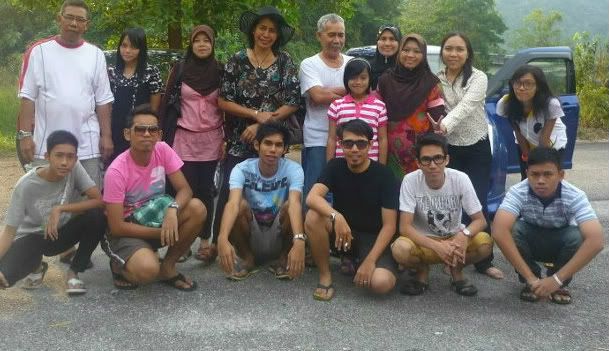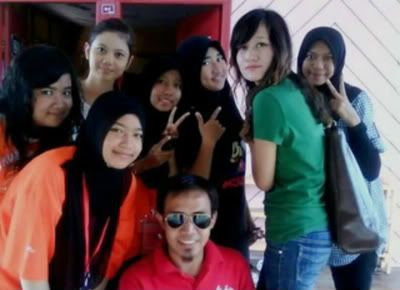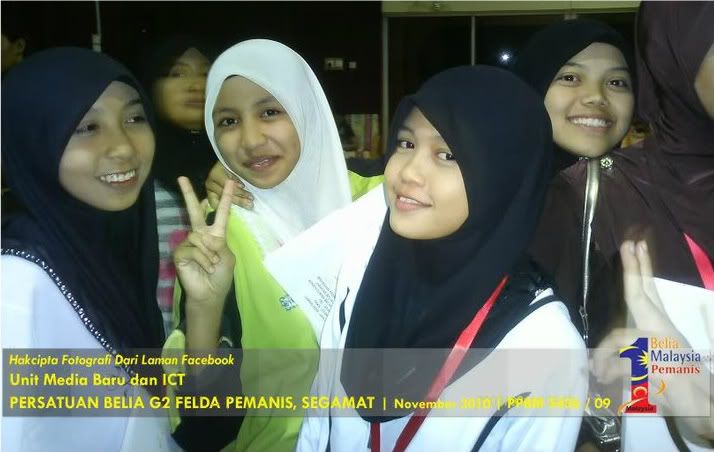A lot of factors at play. Events like 'Peristiwa 13 Mei', 'Rwandan Genocide', Darfur Genocide', 'Balkan War' and 'Kosovo Ehtnic Cleansing' doesnt just happen overnight.
It is important for the Govt of the day to recognise that everyone in the community, regardless of their ethnic origin and economic background be treated equally in freedom, justice and economic terms.
'Peristiwa 13 Mei' happened largely because there is general feeing among the Malay populace that they are being left behind economically. So the tension already simmering to some degree. Then, in General Election of 1969, the Malays lost their political power in Selangor, Pulau Pinang and Melaka? (Is that right?)
It is true that so called 'Malay thugs' went overboard and run amok. But thugs or terrorist are just definition. Someone may be viewed as a terrrorist by Bush, but he/she may be a freedom fighter to another. Doesnt Osama being idolised in Pakistan and Afghanistan?
Mau Mau guerillas in Kenya were terrorists, so does Robert Mugabe's fighters, but today they run their respective countries and call themselves freedom fighters and nationalists.
Let us remind ourselves and the Government that we SHOULD NOT leave a group of people in our society as underclass and poor. Economic pie shall be fairly distributed in our society, and this does not mean, distribution by so called 'racial measure' alone. We all contribute in our nation, whether we work as 'petani', 'tukang sapu sampah' or CEO of a multinational.
It is sad that today, 50 years after Merdeka, we still retain colonial attitudes that petani and tukang sapu sampah as lowly. Status and prestige are measured by our ability to extract the most from society (gaji besar).
We as a nation should move together.
Higher wages for low income workers in a good start.
This article is from Malaysiakini.
What actually happened during the 1969 tragedy
May 11, 07 1:11pm
The series of events surrounding the 'May 13' riot has been documented by Dr Kua Kia Soong in his latest book May 13: Declassified Documents on the Malaysian Riots of 1969 which will be launched on Sunday in conjunction with the 38th anniversary of the tragedy.
This compilation, based on various sets of foreign dispatches and confidential reports at the time - which were declassified recently and made available at the Public Records Office in London - has been dubbed as the first credible account on the incident.
“The real circumstances surrounding the worst racial riot in the history of Malaysia have so far not been made available to the Malaysian public. The official version is fraught with contradictions and inadequacies to which few pay credence,” Kua wrote in the book.
Below are excerpts and summary of the chronology of events based on the declassified documents taken from Kua’s book:
May 10:
The ruling Alliance Party suffered a major setback in the general election although it had managed to retain a simple parliamentary majority. They had lost Penang to the Gerakan Party; Kelantan to the Pan-Malaysian Islamic Party while Perak and Selangor were at the brink of falling into the opposition’s hands.
May 11 and May 12:
On both nights, the opposition celebrated their victory. A large Gerakan procession was held to welcome the left-wing Gerakan leader V David back from winning the federal seat in Penang.
May 13:
The MCA which had suffered badly at the polls, announced that it would withdraw from the cabinet while remaining within the Alliance.
A dispatch from a foreign correspondent showed it is evident that there was a plan for youths mobilised by Umno elements to assemble at then Selangor menteri besar Harun Idris’ residence in the late afternoon. A retaliatory march had been planned although police permission was withheld.
When people were still assembling for the parade, trouble broke out in the nearby Malay section of Kampung Baru, where two Chinese lorries were burnt. The ensuing carnage at Kampung Baru and Batu Road quickly spread elsewhere in Kuala Lumpur.
The foreign correspondent noted the curfew that was imposed was not fairly applied to all.
“In the side streets off Jalan Hale, I could see bands of Malay youths armed with parangs and sharpened bamboo spears assembled in full view of troops posted at road junctions. Meanwhile, at Batu Road, a number of foreign correspondents saw members of the Royal Malay Regiment firing into Chinese shophouses for no apparent reason.”
Prime Minister Tunku Abdul Rahman immediately attributed the violence as triggered off by the behaviour of opposition supporters after the election result announcement while his deputy Tun Abdul Razak pinned the blame on the communists.
May 14:
The riots continued but on a smaller scale. The curfew was only lifted in staggered hours in various districts to allow people to buy food. The police called out all possible reserves and handed over the northern part of the city to the army.
Police put casualties for the previous night incident at 44 killed and about 150 injured. Another dispatch showed the casualties were mainly Chinese as it stated that out of 77 corpses in the morgue of the General Hospital on May 14, at least 60 were Chinese.
The government’s attempts to blame the communists for the riots were however not taken seriously by the officials at the British High Commission (BHC) who could see that the Tunku was not prepared to blame his own people for the riots, nor was he going to blame it on the Chinese “as a whole”.
May 15:
The King proclaimed a state of emergency. The National Operations Council headed by Tun Razak was formed. Tun Razak was still responsible to the Tunku, but all the powers under Emergency Regulations were vested in him.
The curfew had been lifted temporarily in Kuala Lumpur that morning but the situation had rapidly worsened and more sporadic fighting had broken out. Curfews were re-imposed but food was very short.
The local press was suspended until censorship regulations could be drawn up but no attempt was made to supervise reports sent out by foreign correspondents.
May 16:
The situation was still tense in Selangor with cars and houses being burned and fatalities rising. Death tolls had risen to 89 with over 300 injured. 24 hour curfew remained in force in Selangor and had also been imposed in Malacca. In Penang and Perak, the situation had improved although the curfew remained in force.
Tunku made a broadcast in which he announced the setting up of a National Defence Force to be manned by volunteers. The new information minister Hamzah Abu Samah and Tun Razak gave a press conference pinning the blame for the riots on communist infiltration of the opposition parties.
There were reports of looting by the largely Malay military and their bias against the Chinese Malaysians. Number of refugees were increasing.
May 17:
From a BHC telegram, it showed there were skepticism among British officers toward the official figures for fatalities and the preponderance of Chinese casualties among the dead. The police estimated the deaths at about 100 now while British officers estimated the proportion of Chinese to Malay casualties is about 85:15.
The press censorship invited criticism not only from the local press but also in diplomatic circles especially when official statements lacked clarity and credibility.
In a confidential BHC memorandum to the Foreign and Commonwealth Office (FCO), the coup d’etat has been acknowledged and it has effected the transfer of power not only to “Malay hands” but also to the security forces. The latter’s professionalism is questioned.
The BHC also noted the Federal Reserve Unit, which at the time was multiracial in composition, was the more impartial of the security forces while the Malay troops were discriminatory in enforcing the curfew.
“Discriminatory takes the form, for example, of not, repeat not, enforcing the curfew in one of the most violently disposed of the Malay areas in Kuala Lumpur (Kampung Baru) where Malays armed with parangs, etc continue to circulate freely; with the inevitable result that gangs slip through the cordon round the area and attack Chinese outside it. In Chinese areas, the curfew is strictly enforced.”
May 18:
The Tunku qualified his earlier assertion that the disturbances were caused by communists, putting the blame instead on assorted “bad elements”. He also announced the deferment of the Sarawak elections and the continuance of the restrictions on the movement of foreign journalists.
The situation was still unsettled in some parts of the capital city.
May 19:
Less than a week after the riots, the reins of power had effectively passed to Tun Razak, indicating that there had been a plot to bring about the coup d’etat.
“The exact relationship between Tun Razak and the Tunku is not clear. In public Tun Razak says he is directly responsible to the Tunku but he has made it clear privately that he is completely in charge of the country. This could mean the beginning of a process of withdrawal by the Tunku as an effective PM”.
There are some 10,000 reported refugees. The local press was allowed to publish under censorship while foreign journalists had their curfew passes withdrawn. Some opposition politicians were arrested.
May 20:
In a meeting, an Australian High Commissioner had suggested the opposition leaders should be given a role as peace maker but Tun Razak and Ghazali Shafie were firmly against this. “They considered opposition leaders would simply use such an opportunity to promote their own political views.”
The Malaysian Red Cross Society is continuing its daily feeding programme for refugees in various places and over 5,000 had received food supplies.
May 21:
The official statistics of casualties at this juncture were 137 killed (18 Malays), 342 injured, 109 vehicles burned, 118 buildings destroyed and 2,912 persons arrested who were mostly curfew breakers.
May 23:
The declassified documents reveal that Malay troops were not only fraternising with the Malay thugs but were discharging their firearms indiscriminately at Chinese shophouses as they went through the city.
“When confronted by foreign correspondents with reports of racial discrimination, Tun Razak flatly denied them. Following this, curfew passes issued to foreign journalists were withdrawn and reporters were ordered to remain indoors ‘for their own safety’.”
A foreign correspondent’ s report showed the Malay hooligans were detested by the law-abiding Malays of Kampung Baru.
Internal security and home minister Tun Dr Ismail indicated that the Internal Security Act would be in future amended to “counter changing communist tactics”. It was disclosed that of the 3,699 arrested during the crisis, 952 were members of secret societies.
May 24:
Law and order has been re-established in Kuala Lumpur and the atmosphere in the town had improved. People were going back to work (in non-curfew hours) and the government offices were limbering into action. The curfew remained in force (from 3pm to 6.30am of the following day). The government was not ready to admit that it was armed Malay youth who had caused the disturbances.
May 27:
The Tunku was under pressure to resign as he was clearly incensed by foreign journalists’ speculations about his weakening position and got his private secretary to write a protest note to the BHC.
May 28:
A confidential report by the BHC to the FCO on this day observed the government’s attempts to blame the communists for the disturbances were an attempt to justify their new authoritarian powers.
June:
The riots had been under control but they were still sporadic outbreaks of civil disturbances. A BHC report noted violence erupted again in one part of Kuala Lumpur on the night of June 28 and 29, a number of houses were burnt and the casualties were officially given as five killed and 25 injured. Some disturbances toward the end of June also involved ethnic Indians.
July:
Renewed trouble in which one policeman was killed was quickly stopped from spreading in Kuala Lumpur by positive police action.
Tun Ismail’s firm stand in ordering the security forces to act firmly ‘without favour or discrimination’ to any communal group and the Tunku’s announcement of a National Goodwill Committee made up of politicians of all parties went some way toward allaying the fears of the people.
Tun Ismail also revealed the total arrests since May now stood at 8,114, comprising people “from all the major racial groups”. Of these, 4,192 had been charged in court, 675 released on bail, 1,552 unconditionally released and 1,695 preventively detained.
Situation in the Peninsula had improved substantially but tension remains high in sensitive areas of Malacca, Perak and Selangor.
Tension had begun to ease until Malay agitation connected with Tunku’s return to a position of influence and the removal of Dr Mahathir Mohamad from Umno’s general committee on July 12 had heightened it again. Malay university students petitioned for Tunku’s resignation and demonstrated on the campus.
Unveiling the 'May 13' riots















